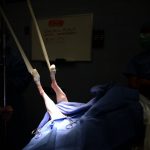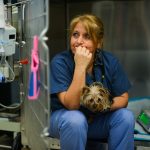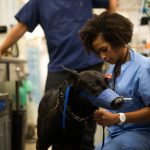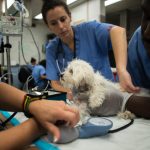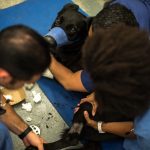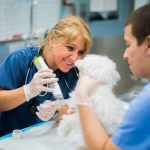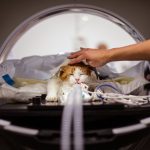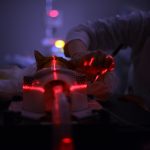Special pets hospital
 Welcome to the special hospital where pets are treated better than most human patients
Welcome to the special hospital where pets are treated better than most human patients
By Rafi Letzter From Business Insider
This post includes graphic images of surgery, some of which may be upsetting to readers.
Emergency veterinary medicine is rough work.
“Some people can’t take the screaming,” said Sue Maraczi, an emergency and critical care nurse at the Animal Medical Center (AMC) on Manhattan’s Upper East Side.
“But you have to consider that [the animals] are sick, they don’t feel well, they’re in a weird place, there’s unfamiliar faces.”
She held a Yorkie in her lap. It didn’t need any treatment right that second, but cried pitifully whenever it was left alone in its cage.
Like any big-city hospital, patients show up at AMC’s emergency room with problems ranging from sniffles to abuse to horrible injuries. Down the hall in the intensive care unit, a team of veterinarians and technicians care for a small army of critical and terminal creatures.
AMC is the most advanced animal hospital in New York City, and among the most advanced treatment centers anywhere in the country. It’s a place where cats and dogs routinely get state-of-the-art radiation treatment for brain cancer, total hip replacements, and even alternative treatments like acupuncture.
One day this summer, I spent 13 hours in the ER: trailing doctors, talking to vets, and watching how they treated the hundreds of animals in the building.
It’s an expensive, luxury level of care for people who treat their pets with the same concern that they’d afford a member of their own family, as many AMC veterinarians and staff emphasized.
Animal Medical Center Veterinarian vet veterinary surgery_13 Rafi Letzter/Business Insider
“We get dogs helicoptered in all the time,” said Lori Asprea, a technician in internal medicine.
On the day I visited AMC, a cat was released after receiving more than $50,000 in care.
Asprea described one dog that came in with severe leptospirosis, an infection most common in canines but that can jump to humans. When he arrived — on a private jet — his kidneys had already failed. He seemed to recover with treatment, but when it came time to release him back to his owners, a potentially fatal clot clogged up the blood vessels in his lungs, sending him back to the ICU. Another clot killed off flesh on one of his legs.
Today, she said, he runs marathons with his owner.
(Some identifying details, like the names of certain pets, are withheld or altered because of an agreement with AMC intended to protect the identity of the center’s patients.)
***
Often, pet owners show up at AMC without the cash on hand or insurance to cover emergency treatment.
On the day I visited, a small white dog named Daisy showed up both of her front paws hanging limp. Daisy had leapt off a high curb after her owner and, Maraczi determined, broken both her legs on the asphalt. Treating her would likely cost several thousand dollars, which her owners could not afford to pay.
The next step for AMC staff in this situation is to ask if the owners want to open a line of credit for their pets. Many, especially those who bring in young pets like Daisy with major injuries, say yes.
Daisy’s owners agreed, but said they expected to fail the hospital’s credit check. ER vets began to discuss whether it was time to tell the owners about AMC’s payment relief plan. AMC, a nonprofit with high operation costs, keeps the lower-cost option as a last resort to avoid sending seriously sick or injured animals away untreated.
“I’ve seen people refinance, sell things, you name it,” Maraczi said.
It happens even when AMC’s staff thinks the animals or their owners would be better off without extreme interventions. “It’s easier to give advice than to take it,” she added.
Before it came time to offer Daisy’s owners payment relief, they got approved for $3,000 in hospital credit.
***
The standard of care at AMC — and the lengths people go to secure it for their pets — can be jarring for pet owners who consider spaying, neutering, shots, an annual checkup, and end-of-life euthanasia their cat or dog’s due at the local clinic. But to AMC’s vets and technicians, it’s obvious that people would want for their animals the same treatment they’d expect for their children.
And it’s clear that they love pushing the boundaries of the possible in veterinary medicine.
Rachel St. Vincent, AMC’s radiation oncologist, uses a linear accelerator purchased from a human hospital to finely target and burn away brain tumors and other cancers that resist surgical intervention.
She studied alongside human radiation oncologists, and described her fellow students gathering around, fascinated, to see how she would apply what they learned to the alien anatomies of dogs and cats. Many of her patients are enrolled in clinical trials that will inform how people with cancer are eventually treated.
Robert Hart, director of orthopedic surgery at AMC, excitedly showed me the glue-free 3D-printed hip replacement he uses in large dogs. The high-tech structure induces the bone itself to grow into its nooks and crannies. It’s a treatment not yet available to humans.
These advances to appear to emerge from more than just detached scientific interest. Every AMC vet and technician I asked owned multiple pets, often animals adopted after they were abandoned and ended up at AMC.
Asprea adopted her dog, Shadow, after he was dumped out of a moving car and ended up in the ER.
“Oh he looks like a project that will cost me thousands of dollars,” she said, laughing, “where do I sign?”
Maraszi said she has something close to a rescue menagerie at home: one Caribbean island dog with just three legs, another with all its original limbs, a poodle mix that had been electrocuted and ended up at AMC, three cats, and a cockatoo found in the trash that now enjoys regular laser skin treatment and acupuncture at AMC.
***
The pace of work at AMC’s ER resembles that in an emergency system geared toward humans.
The hospital is staffed 24 hours a day, as doctors and technicians rotate in and out. The workload is unpredictable. The flow of patients ebbs and flows, seemingly at random, though the pace seems to pick up in the evening.
That’s when everyone gets done with dinner, Maraczi said.
Animal Medical Center Veterinarian vet veterinary surgery_24 Rafi Letzter/Business Insider
One of the most important skills AMC’s new technicians learn in the ER and ICU is keeping the animals calm while the vets work.
Romper, a large black German Shepherd mix, showed up in the ER after leaping through a closed glass window trying to chase a cat. He was agitated, with slices up and down his legs, and tried to bite the vet who triaged him.
With his owner’s help, the staff got him in a muzzle. But while he waited in the back room for the vets and his owner to decide on a treatment plan, he grew anxious, breathing heavily, rolling his eyes, and drooling. Every few minutes, he’d pull hard on his leash.
Omar, a young technician building experience before vet school, held Romper in place. When it was time to stitch him up, Omar wrapped him in a tight bear hug. When Romper calmed a little, Omar helped lay him on the floor so an anesthesiologist could prepare intravenous drugs. Once Romper was asleep, the team made quick work of cleaning and closing his wounds.
At that point, it was 10 pm — my cue to leave the ER staff in peace. As I walked out the door, a woman passed me pushing a bloody mess of fur and torn skin on an improvised stretcher.
“Please somebody help!” She called into the waiting room. “Somebody help me!”
An attendant broke from behind the front desk at a run.
IMAGES:
Animal Medical Center Veterinarian vet veterinary surgery Sue Maraczi comforts a patient. Rafi Letzter/Business Insider
Animal Medical Center Veterinarian vet veterinary surgery_27 Rafi Letzter/Business Insider
Animal Medical Center Veterinarian vet veterinary surgery A team of vets perform surgery to repair a small dog’s knee. Rafi Letzter/Business Insider
Animal Medical Center Veterinarian vet veterinary surgery Emergency room veterinarians and technicians tend to Daisy. Rafi Letzter/Business Insider
Animal Medical Center Veterinarian vet veterinary surgery Rafi Letzter/Business Insider
Animal Medical Center Veterinarian vet veterinary surgery_07 Rafi Letzter/Business Insider
cat in a CAT scan veterinarian animal medical center Rafi Letzter/Tech Insider
Maia the cat gets a CAT scan. The data will allow St. Vincent to target Maia’s nasal tumor. Rafi Letzter/Tech Insider
Animal Medical Center Veterinarian vet veterinary surgery Rafi Letzter/Business Insider
For more on this story go to: http://www.businessinsider.com/animal-medical-center-veterinarian-emergency-2016-9?utm_source=feedburner&%3Butm_medium=referral&utm_medium=feed&utm_campaign=Feed%3A+businessinsider+%28Business+Insider%29

